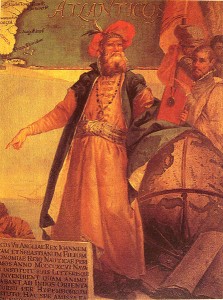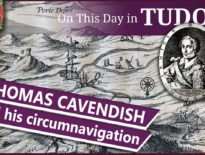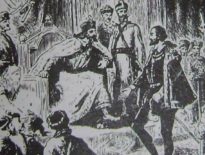 John Cabot was born in 1451 and was the son of Julio Caboto and his wife Mattea, both of whom were Italian. Little is known of his early life; however, we know that John was granted Venetian citizenship on 28th March 1476, which granted him the right to trade and engage in maritime activities. His business activities have been traced in Venetian archives between the years 1482 and 1485; however, we do not know where he acquired his merchant or navigational training. In April 1493, while Cabot was in Valencia, Columbus passed through the city on his way to Barcelona, leaving historians with the belief that the two men met and that it was Columbus who inspired Cabot to become a transatlantic voyager. Indeed, a Spanish diplomat described Cabot as another Columbus, seeking people to aid him in his journey of discovery. At this time, Bristol was renowned for having an interest in transatlantic voyages, and it was said that the city was involved in Atlantic exploration from 1480. With this in mind, in or around 1495, John Cabot moved to Bristol.
John Cabot was born in 1451 and was the son of Julio Caboto and his wife Mattea, both of whom were Italian. Little is known of his early life; however, we know that John was granted Venetian citizenship on 28th March 1476, which granted him the right to trade and engage in maritime activities. His business activities have been traced in Venetian archives between the years 1482 and 1485; however, we do not know where he acquired his merchant or navigational training. In April 1493, while Cabot was in Valencia, Columbus passed through the city on his way to Barcelona, leaving historians with the belief that the two men met and that it was Columbus who inspired Cabot to become a transatlantic voyager. Indeed, a Spanish diplomat described Cabot as another Columbus, seeking people to aid him in his journey of discovery. At this time, Bristol was renowned for having an interest in transatlantic voyages, and it was said that the city was involved in Atlantic exploration from 1480. With this in mind, in or around 1495, John Cabot moved to Bristol.
Cabot arrived in Bristol with his wife and his sons, Lewis, Sebastian and Sancio, and rented a house in Nicholas Street. After he’d put his proposals to Bristol sailors, Cabot’s plans for a transatlantic voyage soon reached the attention of the royal court. On 5th March 1496, Henry VII responded to a petition put forward by Cabot, granting him and his sons free reign to sail to the lands east, west and north. They were, however, excluded from sailing to the south as the Spanish had claims there. Any lands that Cabot discovered were to be held in the king’s name, granting him exclusive rights of access.
The first voyage set sail in June; however, it was unsuccessful. Strong winds, short supplies, and a disruptive crew forced Cabot to turn back. He was not deterred, and on 20th May 1497, he set sail again with a new crew. The source for the voyage is a letter written by a Bristol merchant named John Day. He wrote that the ship sailed with a northeasterly wind for thirty-five days with only one storm before they finally spotted land. We do not know where they initially landed; however, it is believed to have been Cape Degrat off the coast of Newfoundland. When another landing was made, no people were seen, but evidence of human habitation was found in the form of carved spears. They continued their journey and reached the southern tip of Newfoundland at Cape Race. With harbours and islands noted, Cabot set sail for England on or around 20th July.
Reaching Bristol in August, Cabot travelled to London for an audience with the king. King Henry VII gave Cabot £10 for his voyage and granted him a pension of £20 a year. John Cabot reportedly became a famous figure for his expedition, with sources noting that he was called the ‘Great Admiral’ and had a swathe of admirers.
The following year, at the beginning of May 1498, Cabot once again set sail for Newfoundland with a fleet of five ships. One ship was reported to have docked in Ireland to avoid a storm, while the other four ships continued on their journey. The exact fate of John Cabot is unknown as we hear nothing more of him following this. There is much speculation regarding his death, with some believing he returned and died shortly after, as one of the men scheduled to accompany Cabot was reported as living in London in 1501. However, the majority of people believe that John Cabot was sadly lost at sea.
Georgia Whitehead has just finished her masters in Classics at the University of Edinburgh. Academically, Georgia is interested in early Christianity, with her master's thesis focusing on "The Male Gaze and Self-Representation in Female Christian Narratives". In addition to her interest in ancient history, she has always been an avid lover of the Tudor era, drawn to the magnificence of the Tudor courts and the larger than life characters. She is particularly interested in The Reformation, Christianity and the shifting sands of ecclesiastical politics in this period and also has a keen interest in the lives of Tudor women. It is Georgia's ambition to become a writer, perhaps publishing her own Tudor novel one day.
Georgia also runs a history blog and instagram page called Historia Mundis.
Bibliography
- J. A. Williamson, The Cabot voyages and Bristol discovery under Henry VII, Hakluyt Society, 2nd ser., 120 (1962)
- S. E. Morison, The European discovery of America: the northern voyages (1971)
- A. A. Ruddock, ‘John Day of Bristol and the English voyages across the Atlantic before 1497’, GJ, 132 (1966), 225–33
- E. T. Jones, ‘Alwyn Ruddock: John Cabot and the discovery of America’, Historical Research, 81 (2008), 224–54
- D.B.Quinn. ‘John Cabot’ Oxford Dictionary of National Biography (2004)



Leave a Reply